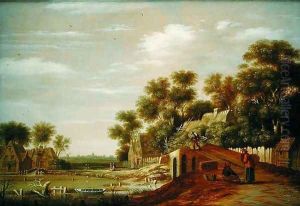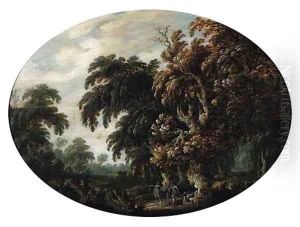Rafel Govertsz Camphuysen Paintings
Rafel Govertsz Camphuysen was a Dutch Golden Age painter, poet, and etcher, known for his tranquil landscapes and domestic scenes imbued with a serene, contemplative atmosphere. Born in Gorinchem (or Gorkum), Netherlands, in 1597, Camphuysen's artistic journey began in an era defined by the flourishing of arts and culture, which characterized the Dutch Golden Age. Despite the prominence of his work today, details about his early life and training are somewhat scarce, reflecting the common challenges in tracing the biographies of even significant artists from this period.
Camphuysen initially emerged on the artistic scene as a poet before his talents as a painter became widely recognized. His transition from poetry to painting is indicative of the interwoven nature of the arts during the 17th century in the Netherlands. His works often depict serene landscapes, pastoral scenes, and the simple interiors of Dutch homes, showcasing his ability to capture the interplay of light and shadow, a hallmark of Dutch painting at the time. His landscapes, in particular, are noted for their peacefulness and the sense of calm they evoke, often featuring cattle and figures in harmonious compositions.
Besides landscapes, Camphuysen also explored religious themes in his art, albeit less frequently. These works are characterized by a similar sensitivity to atmosphere and mood, focusing on intimate, devotional moments rather than grand biblical narratives. His etchings, a medium that allowed for detailed expression and widespread reproduction, contributed significantly to his reputation and the dissemination of his style.
Throughout his career, Camphuysen faced the challenges of an artist's life in the 17th century, including the need to navigate the preferences of patrons and the art market. Despite these challenges, he managed to secure a place for himself within the competitive Dutch art scene. His work was appreciated for its quiet beauty and technical skill, elements that continue to resonate with audiences today.
Camphuysen's death in 1657 marked the end of a career that had contributed to the rich tapestry of Dutch Golden Age art. Today, his paintings and etchings can be found in numerous collections and museums, serving as a testament to his skill and sensitivity as an artist. Through his work, Rafel Govertsz Camphuysen offers a window into the quieter, contemplative aspects of 17th-century Dutch life, making his art enduringly appealing to those who seek refuge in the serene landscapes of the past.





